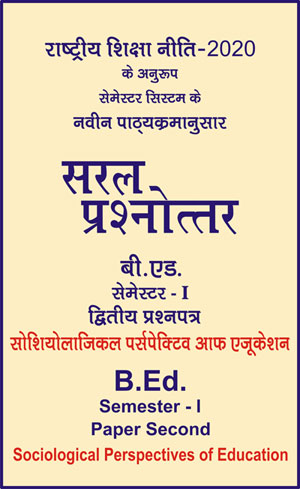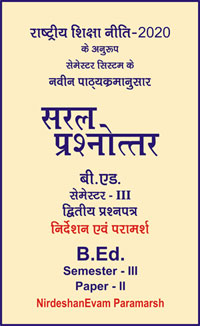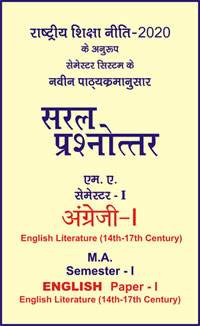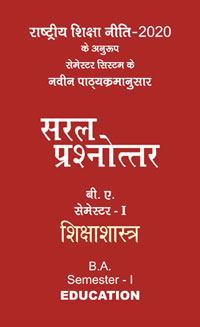|
बी एड - एम एड >> बी.एड. सेमेस्टर-1 प्रश्नपत्र-II - सोशियोलाजिकल पर्सपेक्टिव आफ एजूकेशन बी.एड. सेमेस्टर-1 प्रश्नपत्र-II - सोशियोलाजिकल पर्सपेक्टिव आफ एजूकेशनसरल प्रश्नोत्तर समूह
|
|
|||||||
बी.एड. सेमेस्टर-1 प्रश्नपत्र-II - सोशियोलाजिकल पर्सपेक्टिव आफ एजूकेशन (अंग्रेजी भाषा मे)
Question- Describe issues relating to inequality discrimination and marginalization that stands “in the way of universalization of education”.
Ans.
Discrimination in Education
Discrimination in Education is the act of discriminating against people belonging to certain categories in enjoying full right to education. It is considered a violation of human rights. Education discrimination can be on the basis of ethnicity nationality age, gender, race, economic condition, disability and religion.
The Convention against Discrimination in Education adopted by UNESCO on 14 December 1960 aims to combat discrimination and racial segregation in education. As at December 2020, 106 states were members of the Convention.
MEANING OF MARGINALIZED GROUPS AND MARGINALIZATION
In general, the term ‘marginalization’ describes the overt actions or tendencies of human societies, where people who they perceive to be undesirable or without useful function, are excluded, i.e., marginalized. These people, who are marginalized, from a GROUP or COMMUNITY for their protection and integration and are known as ‘marginalized groups’. This limits their opportunities and means for survival. Peter Leonard defines marginality as, “... being outside the mainstream of productive activity and/or social reproductive activity”.
Latin observes that “Marginality” is so thoroughly demeaning, for economic well-being, for human dignity, as well as for physical security. Marginal groups can always be identified by members of dominant society, and will face irrevocable discrimination”.
These definitions are mentioned in different contexts and show that marginalization is a slippery and multilayered concept. Marginalization has aspects in sociological, economic, and political debates.
It would generally be true, that there would exist more “marginalized groups in the Third World”, and developing nations, that in the Developed/First-World nations.
To further clarify the meaning and concept we are going to discuss certain characteristics of marginalized groups :
Usually, a minority group has the following characteristics:
(1) They have physcial and / or cultural traits that set them apart,
(2) They have shared social rules about who belongs, and who does not.
(3)They have a tendency to marry within thé group.
Various Marginalised Groups and Their Problems - They are as under :
-
Women - Women may be excluded from certain jobs and occupations, incorporated into certain others, and marginalized in others. In general, they are always marginalized relative to men, in every country and culture. Women (or, men) don’t present a homogeneous category where members have common interests abilities, or practices. Women belonging to lower classes, lower castes, illiterate and the poorest region have different levels of marginalization than their better-off counterparts.
-
People with Disabilities - People with disabilities have had to battle against centuries of biased assumptions. The stigmatization of disability resulted in the social and economic marginalization of generations with disabilities. The proportion of the disabled population in India is about 21.9 million.
-
Schedule Castes (Dalits) - The caste system is a serious problem in India society. This system make discrimination in society.
The caste system is a strictly hierarchical social system based on underlying notions of purity and pollution, Brahmins are on the top of the hierarchy and Shudras or Dalits constitute the bottom of the hierarchy.” The marginalization of Dalits influences all spheres of their life, violating basic human rights such as civil, political, social, economic and cultural rights.
Caste-based marginalization is one of the most serious human rights issues in the world today, adversely affecting more than 260 million people mostly reside in India.
- Scheduled Tribes - In India, the Scheduled Tribes population is around 84.3 million and is considered to be socially and economically disadvantaged. Their percentages in the population and numbers, however, vary from State to State. They are mainly landless with little control over resources such as land, forest, and water.
They constitute a large proportion of agricultural labourers, casual laborers, plantation laborers, industrial laborers etc. This has resulted in poverty among them, low levels of education, poor health.
- Elderly of Aged People - In India, the population of the elderly is growing rapidly and is emerging as a serious area of concern for the government and the policy planners. According to data on the age of India’s population, in Census 2001, there are a little over 76.6 million people above 60 years, constituting 7.2 percent of the population.
The widowers among older men form 14.9 percent as against 50.1 percent widows among elderly women. Lack of economic dependence has an impact on their access to food, clothing, and healthcare. Among the basic needs of the elderly, medicine features as the highest unmet need.
- Children -Poverty has a direct impact on the mortality and morbidity among children. In India, a girl child faces discrimination and differential access to nutritious food and gender-based violence is evident from the falling sex ratio and the use of technologies to eliminate the girl child. The manifestations of these violations are various, ranging from child labour, child trafficking, to commercial sexual exploitation and many other forms of violence and abuse
Among children, there are some groups like street children and children of sex workers who face additional forms of discrimination.
- Sexual Minorities - Another group that faces - discrimination are sexual minorities. Those identified as gay, lesbian, transgender, bisexual, kothi and hijra; experience various forms of discrimination within the society and the health system
Individuals who are identified as having same-sex sexual preferences are ridiculed and ostracized by their own family and are left with very limited support structures and networks of community that provide the conditions of care and support.
Educational Inequality - Educational inequality is the unequal distribution of academic resources, including but not limited to; school funding, qualified and experienced teachers, books, and technologies to socially excluded communities. These communities tend to be historically disadvantaged and oppressed. Individuals belonging to these marginalized groups are often denied access to schools with adequate resources. Inequality leads to major differences in the educational success or efficiency of these individuals and ultimately suppresses social and economic mobility. Inequality in education is broken down in different types: Regional inequality, inequality by sex, inequality by social stratification, inequality by parental income, inequality by parent occupation, and many more. Educational inequality between White students and minority students continues to perpetuate social and economic inequality.
Throughout the world, there have been continuous attempts to reform education at all levels. With different causes that are deeply rooted in history, society, and culture, this inequality is difficult to eradicate.Although difficult, education is vital to society's movement forward. It promotes “citizenship, identity, equality of opportunity and social inclusion, social cohesion as well as economic growth and employment” and for these reasons, equality is widely promoted. Global educational inequality is clear in the ongoing learning crisis, where over 91% of children across the world are enrolled in primary schooling; however, a large proportion of them are not learning.
Family Background - Children, then, enter school at different levels. Poor students are behind in verbal memory, vocabulary, math, and reading achievement, and have more behaviour problems. This leads to their placement in different level classes that tracks them. These courses almost always demand less from their students, creating a group that is conditioned to lack educational drive. These courses are generally non-college bound and are taught by less-qualified teachers.
The recent and drastic increase of Latino immigrants has created another major factor in educational inequality. As more and more students come from families where English is not spoken at home, they often struggle with overcoming a language barrier in addition to simply learning subjects. They more frequently lack assistance at home because it is common for the parents to not understand the work that is in English.
Gender - Throughout the world, educational achievement varies by gender. The exact relationship differs across cultural and national contexts.
Female Disadvantage - This ‘girls gap’ is concentrated in several countries including somalia, Afghanistan Togo , the Central African Republic and Democratic Republic of the Congo.. In the Democratic Republic of the Congo, girls are outnumbered two to one
Early marriage affects females’ ability to receive an education.
“The gap separating men and women in the job market remains wide in many countries, whether in the North or the South. With marginal variables between most countries, women have a lower emolument rate are unemployed longer, are paid less, and have less secure jobs.
Male Disadvantage - In some countries, female high school and graduation rates are higher than for males. In the United States for example, 33% more bachelor’s degrees were conferred on females than males in 2010-2011.
Special Education - In addition to the unbalanced scale of gender disproportionality in formal education, students with “special needs” comprise yet another facet of educational inequality. Prior to the 1975 passing of the Education for All Handicapped Children Act (currently known as the Individuals with Disabilities Education Act (IDEA)) approximately. 2 million children with special needs were not receiving sufficient public education. Of those that were within the academic system, many were reduced to lower standards of teaching, isolated conditions, or even removal from school buildings altogether and relocated out of peer circulation. The passing of this bill effectively changed the lives of millions of special needs students, ensuring that they have free access to quality public education facilities and services. And while there are those that benefit from the turning of this academic tide, there are still many. students (most of which are minorities with disabilities) that find themselves in times of learning hardship due to the unbalanced distribution of special education funding.
He Right to Education of Transgender People
We are seeing discrimination in education against transgender students challenged more and more, not only by transgender students themselves and their parents, but also by lawmakers and legislators in certain countries where this recognition of rights on the basis of gender identity is being supported by national level application of non-discrimination law.
Equality and non-discrimination are foundational principles of international human rights law where there is a longstanding prohibition against discrimination on the basis of sex. This prohibition is applied specifically to the field of education by the UNESCO Convention against Discrimination in Education (1960, CADE) which stipulates that any and all forms of discrimination in education are prohibited, including on the basis of sex. Increasingly, however, interpretation of non-discrimination law has recognised the unequal treatment of individuals on the basis of gender identity as well as biological sex.
The Committee on Economic, Social and Cultural Rights’ General Comment 20 explicitly states that ‘gender identity is recognised as among the prohibited grounds of discrimination; for example persons who are transgender, transexual or intersex often face serious human rights violations, such as harassment in schools’ (General Comment 20, para.32). ;
The Committee on the Elimination of Discrimination Against Women has also recognised gender identity as grounds for discrimination in the Convention of the Elimination of All Forms of Discrimination Against Women (CEDAW). The Committee’s General Recommendation 33, (para. 8) recognises that ‘discrimination against women is compounded by intersecting factors that affect some women to degrees or in ways that differ from those affecting men or other women. Grounds for intersecting er compounded discrimination may include...identity as a lesbian, bisexual or transgender woman or intersex person.’ And in its most recent General Recommendaton 35, on gender-based violence against women, the Committee recommends states repeal all legislative measures that are ‘discriminatory against women and thereby enshrine, encourage, facilitate, justify or tolerate any form of gender-based violence. In particular provisions that...allow, tolerate or condone forms of gender-based violence against women, including...provisions that criminalise...being lesbian, bisexual or transgender’ (General Recommendation 35, para. 29).
Confusion can arise around the distinction between sex and gender, so it may be helpful to define what is meant by these terms, as wells as ‘gender identity’, ‘transgender’, ‘transexual’, and ‘cisgender’. All but the last of the definitions used here are taken from the som Sd in the comprehensive UNESCO report out in the open. Education sector response to violence based on sexual orientation and gender identity / expression. :
• Sex is the “classification of people as male, female or ‘intersex, assigned at birth, based on anatomy and biology’, while ‘gender’ is ‘the social attributes and opportunities associated with being male and female and the relationships: between women and men and girls and boys; and between women and between men. These attributes, opportunities and relationships are socially constructed and are learned through socialisation processes’.
• Gender ideniity is ‘[a] person’s deeply felt internal and individual experience of gender, which may or may not correspond with the sex assigned to them at birth. This includes the personal sense of the body (which may involve, if freely chosen, modification of bodily appearance or function by medical, surgical or other means) and other expressions of gender, including dress, speech and mannerisms.’
• To identify as transgender is to be ‘[a] person whose gender identity differs from their sex at birth. Transgender people may be male-to-female (female identity and appearance) or female-to-male (male identity and appearance).”
• To. be transexual is to be ‘[a] transgender person who is in the process of, or has undertaken,"treatment (which may include surgery and hormonal treatment) to make their body congruent with their preferred gender’.
• Finally, cisgender is defined by the Oxford English Dictionary as ‘lesignating a person whose sense of personal identity corresponds to the sex and gender assigned to him or her at birth’.
The ability of transgender students to fully enjoy their right to education is impacted in a variety of ways. Most commonly, we see not only deliberate harassment and discrimination by teachers and fellow students leading transgender students to drop out of school, but also the exclusion of transgender students from education by being denied the opportunity to wear the school uniform or use the toilets congruent with their gender identity.
It is a positive development that over recent years, a number of countries have demonstrated progress in translating the right to non-discrimination in education into legislation, thereby ensuring transgender students are free to enjoy their right to education. There has also been a spate of cases in courts around the world ruling favourably for the equal rights of transgender people.
For example, in 2016 a case was successfully taken to the Constitutional Court in Colombia. Erika Comas Gómez, a transgender boy, argued that his right to education was being infringed as his school would not allow him to wear the male uniform nor would they address him according to the gender he identifies as, until he changed his name on his official student identification card. The Colombian Constitutional Court ruled that this requirement was an unnecessary impediment to his enjoyment of the right to education in a way which respected his gender identity.
Further, in the United States in 2016, the Transgender Law Center secured a change to school policy in Horry County, South Carolina. The Center sent a letter to the education board on behalf of a transgender male student who was suspended from school after a teacher saw him using the boys’ toilets. Subsequent to the change in policy, the county superintendent of education stated that in future all transgender children will be able to use the toilets consistent with their gender identity.
Positive moves are also being seen in UK schools to accommodate the legal rights of transgender children to express their gender identity. These include teachers unions calling for more and better training on how to support children who transition while at school, and the NASUWT union publication Trans Equality in Schools: Advice and guidance for teachers and leaders to help schools and colleges support not only pupils but also teachers who transition.
In Argentina, following legislation that came into force in 2012 recognising the right to gender identity based on personal expression, lawmakers in the country’s capital, Buenos Aires, are currently discussing draft legislation that specifically includes provision for transgender people to be free from discrimination in order that they may enjoy their right to free, compulsory and secular education. And in India, a 2014 supreme Court ruling created the official third gender status for transgender people who were also afforded the classification of ‘protected status’ as an economically weaker category of the population, under the 2009 Right to Education Act. This means that not only can transgender students not be excluded from school on the basis of their gender identity, they also enjoy special measures including the guarantee that private schools will reserve a minimum of 25% of places in each class to children from disadvantaged groups.
Some of the most significant legislative steps taken recently have been seen in Chile and Pakistan, the latter being in the process of approving a private members’ bill for the protection and welfare of transgender people. The Transgender Persons (Protection of Rights) Act 2017 was drafted by the Pakistan National Commission on Human Rights, following broad consultation including with NGOs and civil society organisations and is intended to reflect the legal interpretation of international legal mechanisms. Amongst other areas of life, the Act specifically targets discrimination in education with the aim of preventing transgender children from missing out on or not completing their education. -
In the case of Chile, in May 2017 the Chilean education authority (Mineduc-in Spanish) sought to explicitly address discrimination against transgender students in the national school system by sending out guidelines to schools (in Spanish) and other educational establishments promoting the rights of transgender students, their acceptance into and support by the national school system on an equal footing with all students. These guidelines expressly forbid schools from discriminating against students on the basis of gender identity, for example through tolerating any form of bullying and harassment, or by excluding them through not allowing students to wear the uniform or use the toilets that match their gender identity.
Substantial progress is being made in different regions of the world to translate the rights of transgender students to non-discrimination in education into a daily reality for them. However, such freedoms are being challenged by some. Conservative Spanish Catholic group Hazte Oir has used what they call their Freedom Bus to try to disseminate what are viewed by many as openly transphobic messages throughout Spain, the United States, and Latin American countries including Chile. And in February 2017, the Trump administration in the United States withdrew guidance issued by the Obama administration relating to the Title IX education amendments to the 1964 Civil Rights Act, which extended protections afforded by Title IX on the basis of sex extended to include gender identity. The Trump administration, in withdrawing the guidance, stated that the Department of Education needed to ‘more completley consider the legal issues involved.’ Therefore, despite significant progress, particularly in the legal recognition, at both the international and national levels, of gender identity as grounds of discrimination, there is still a long way to go until the right of transgender students to education on the basis of non-discrimination is universally respected.
|
|||||

 i
i 










